Performance of High-Layer-Thickness Ti6Al4V Fabricated by Electron Beam Powder Bed Fusion under Different Accelerating Voltage Values
Abstract
:1. Introduction
2. Experimental Procedure
2.1. Materials
2.2. Equipment and Manufacturing Process
2.3. Characterization
3. Results and Discussion
3.1. Relative Densities and Surface Morphologies
3.2. Microstructure
3.3. Tensile Properties
3.4. Building Rates
4. Conclusions
Author Contributions
Funding
Conflicts of Interest
References
- Körner, C. Additive manufacturing of metallic components by selective electron beam melting—A review. Int. Mater. Rev. 2016, 61, 361–377. [Google Scholar] [CrossRef] [Green Version]
- Guo, C.; Ge, W.; Lin, F. Effects of scanning parameters on material deposition during Electron Beam Selective Melting of Ti-6Al-4V powder. J. Mater. Process. Technol. 2015, 217, 148–157. [Google Scholar] [CrossRef]
- Juechter, V.; Scharowsky, T.; Singer, R.F.; Körner, C. Processing window and evaporation phenomena for Ti-6Al-4V produced by selective electron beam melting. Acta Mater. 2014, 76, 252–258. [Google Scholar] [CrossRef] [Green Version]
- Li, Y.; Liang, X.; Yu, Y.; Li, H.; Kan, W.; Lin, F. Microstructures and mechanical properties evolution of IN939 alloy during electron beam selective melting process. J. Alloys Compd. 2021, 883, 160934. [Google Scholar] [CrossRef]
- Kenevisi, M.S.; Lin, F. Selective electron beam melting of high strength Al2024 alloy; microstructural characterization and mechanical properties. J. Alloys Compd. 2020, 843, 155866. [Google Scholar] [CrossRef]
- Zhong, Y.; Rännar, L.-E.; Liu, L.; Koptyug, A.; Wikman, S.; Olsen, J.; Cui, D.; Shen, Z. Additive manufacturing of 316L stainless steel by electron beam melting for nuclear fusion applications. J. Nucl. Mater. 2017, 486, 234–245. [Google Scholar] [CrossRef]
- Ramirez, D.A.; Murr, L.E.; Li, S.J.; Tian, Y.X.; Martinez, E.; Martinez, J.L.; Machado, B.I.; Gaytan, S.M.; Medina, F.; Wicker, R.B. Open-cellular copper structures fabricated by additive manufacturing using electron beam melting. Mater. Sci. Eng. A 2011, 528, 5379–5386. [Google Scholar] [CrossRef]
- Ramsperger, M.; Singer, R.F.; Körner, C. Microstructure of the Nickel-Base Superalloy CMSX-4 Fabricated by Selective Electron Beam Melting. Metallurg. Mater. Trans. A 2016, 47, 1469–1480. [Google Scholar] [CrossRef] [Green Version]
- Zhou, J.; Li, H.; Yu, Y.; Li, Y.; Qian, Y.; Firouzian, K.; Lin, F. Research on aluminum component change and phase transformation of TiAl-based alloy in electron beam selective melting process under multiple scan. Intermetallics 2019, 113, 106575. [Google Scholar] [CrossRef]
- Karlsson, J.; Snis, A.; Engqvist, H.; Lausmaa, J. Characterization and comparison of materials produced by Electron Beam Melting (EBM) of two different Ti-6Al-4V powder fractions. J. Mater. Process. Technol. 2013, 213, 2109–2118. [Google Scholar] [CrossRef]
- Galarraga, H.; Lados, D.A.; Dehoff, R.R.; Kirka, M.M.; Nandwana, P. Effects of the microstructure and porosity on properties of Ti-6Al-4V ELI alloy fabricated by electron beam melting (EBM). Addit. Manuf. 2016, 10, 47–57. [Google Scholar] [CrossRef] [Green Version]
- DebRoy, T.; Mukherjee, T.; Milewski, J.O.; Elmer, J.W.; Ribic, B.; Blecher, J.J.; Zhang, W. Scientific, technological and economic issues in metal printing and their solutions. Nat. Mater. 2019, 18, 1026–1032. [Google Scholar] [CrossRef] [PubMed]
- Ma, M.; Wang, Z.; Gao, M.; Zeng, X. Layer thickness dependence of performance in high-power selective laser melting of 1Cr18Ni9Ti stainless steel. J. Mater. Process. Technol. 2015, 215, 142–150. [Google Scholar] [CrossRef]
- Shi, X.; Ma, S.; Liu, C.; Chen, C.; Wu, Q.; Chen, X.; Lu, J. Performance of High Layer Thickness in Selective Laser Melting of Ti6Al4V. Materials 2016, 9, 975. [Google Scholar] [CrossRef] [Green Version]
- Sufiiarov, V.S.; Popovich, A.A.; Borisov, E.V.; Polozov, I.A.; Masaylo, D.V.; Orlov, A.V. The Effect of Layer Thickness at Selective Laser Melting. Proced. Eng. 2017, 174, 126–134. [Google Scholar] [CrossRef]
- Wang, S.; Liu, Y.; Shi, W.; Qi, B.; Yang, J.; Zhang, F.; Han, D.; Ma, Y. Research on High Layer Thickness Fabricated of 316L by Selective Laser Melting. Materials 2017, 10, 1055. [Google Scholar] [CrossRef] [Green Version]
- Shi, W.; Wang, P.; Liu, Y.; Hou, Y.; Han, G. Properties of 316L formed by a 400 W power laser Selective Laser Melting with 250 μm layer thickness. Powder Technol. 2020, 360, 151–164. [Google Scholar] [CrossRef]
- Shi, X.; Yan, C.; Feng, W.; Zhang, Y.; Leng, Z. Effect of high layer thickness on surface quality and defect behavior of Ti-6Al-4V fabricated by selective laser melting. Opt. Laser Technol. 2020, 132, 106471. [Google Scholar] [CrossRef]
- Shi, W.; Liu, Y.; Shi, X.; Hou, Y.; Wang, P.; Song, G. Beam Diameter Dependence of Performance in Thick-Layer and High-Power Selective Laser Melting of Ti-6Al-4V. Materials 2018, 11, 1237. [Google Scholar] [CrossRef] [PubMed] [Green Version]
- Tang, H.P.; Yang, G.Y.; Jia, W.P.; He, W.W.; Lu, S.L.; Qian, M. Additive manufacturing of a high niobium-containing titanium aluminide alloy by selective electron beam melting. Mater. Sci. Eng. A 2015, 636, 103–107. [Google Scholar] [CrossRef]
- Rännar, L.-E.; Koptyug, A.; Olsén, J.; Saeidi, K.; Shen, Z. Hierarchical structures of stainless steel 316L manufactured by Electron Beam Melting. Addit. Manuf. 2017, 17, 106–112. [Google Scholar] [CrossRef]
- Li, H.; Yu, Y.; Li, Y.; Lin, F. Effects of the higher accelerating voltage on electron beam powder-bed based additive manufacturing of Ti6Al4V alloy. Addit. Manuf. 2022, 50, 102579. [Google Scholar] [CrossRef]
- Dumonte, P.; Sayegh, G. Effects of Accelerating Voltage on the Penetration in Electron-Beam Welding. In Advances in Welding Processses, Proceedings of the Third International Conference, Harrogate, UK, 7–9 May 1974; Needham, J.C., Ed.; Welding Institute: Cambridge, UK, 1974; Volume 1–2, pp. 160–167. [Google Scholar]
- Guo, C.; Ge, W.; Lin, F. Dual-Material Electron Beam Selective Melting: Hardware Development and Validation Studies. Engineering 2015, 1, 124–130. [Google Scholar] [CrossRef] [Green Version]
- Guo, C.; Zhang, J.; Zhang, J.; Ge, W.; Yao, B.; Lin, F. Scanning system development and digital beam control method for electron beam selective melting. Rapid Prototyp. J. 2015, 21, 313–321. [Google Scholar] [CrossRef]
- Puebla, K.; Murr, L.E.; Gaytan, S.M.; Martinez, E.; Medina, F.; Wicker, R.B. Effect of Melt Scan Rate on Microstructure and Macrostructure for Electron Beam Melting of Ti-6Al-4V. Mater. Sci. Appl. 2012, 03, 259–264. [Google Scholar] [CrossRef] [Green Version]
- Wu, C.; Zafar, M.Q.; Zhao, H.; Wang, Y.; Schöler, C.; Heinigk, C.; Nießen, M.; Schulz, W. Multi-physics modeling of side roughness generation mechanisms in powder bed fusion. Addit. Manuf. 2021, 47, 102274. [Google Scholar] [CrossRef]
- Bauereiß, A.; Scharowsky, T.; Körner, C. Defect generation and propagation mechanism during additive manufacturing by selective beam melting. J. Mater. Process. Technol. 2014, 214, 2522–2528. [Google Scholar] [CrossRef]
- Scharowsky, T.; Juechter, V.; Singer, R.F.; Korner, C. Influence of the Scanning Strategy on the Microstructure and Mechanical Properties in Selective Electron Beam Melting of Ti-6Al-4V. Adv. Eng. Mater. 2015, 17, 1573–1578. [Google Scholar] [CrossRef]
- Vilaro, T.; Colin, C.; Bartout, J.D. As-Fabricated and Heat-Treated Microstructures of the Ti-6Al-4V Alloy Processed by Selective Laser Melting. Metall. Mater. Trans. A 2011, 42, 3190–3199. [Google Scholar] [CrossRef]


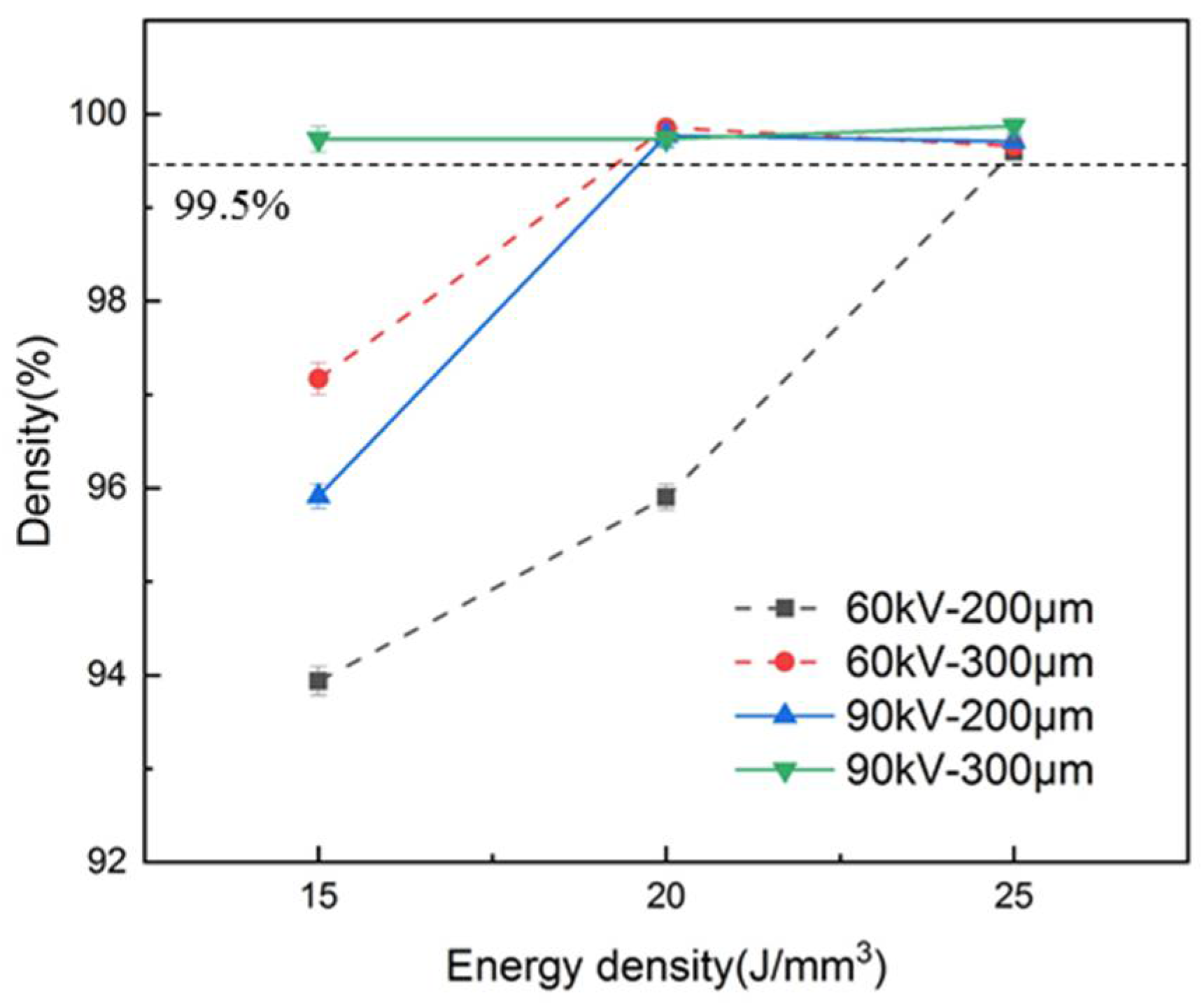
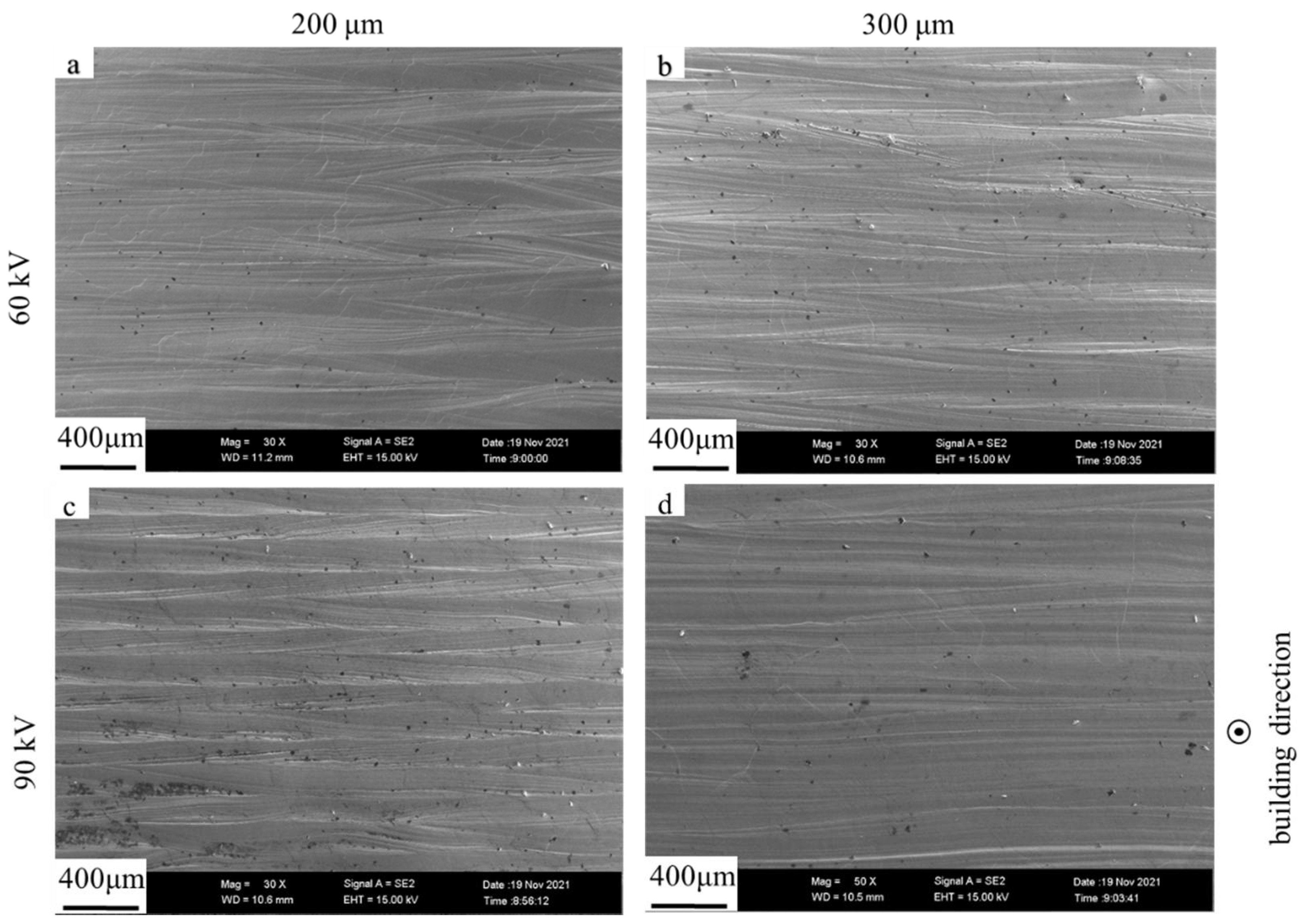

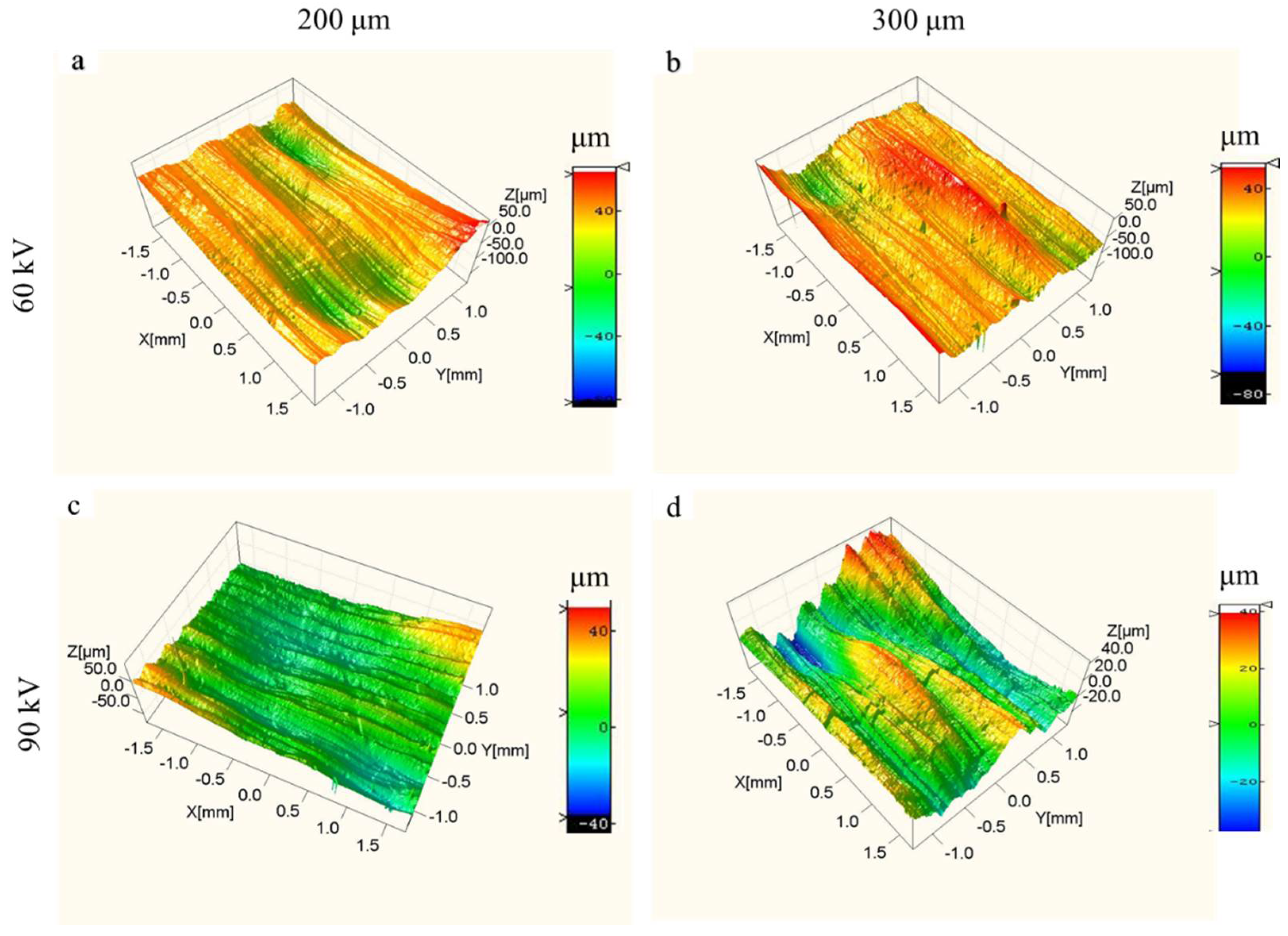



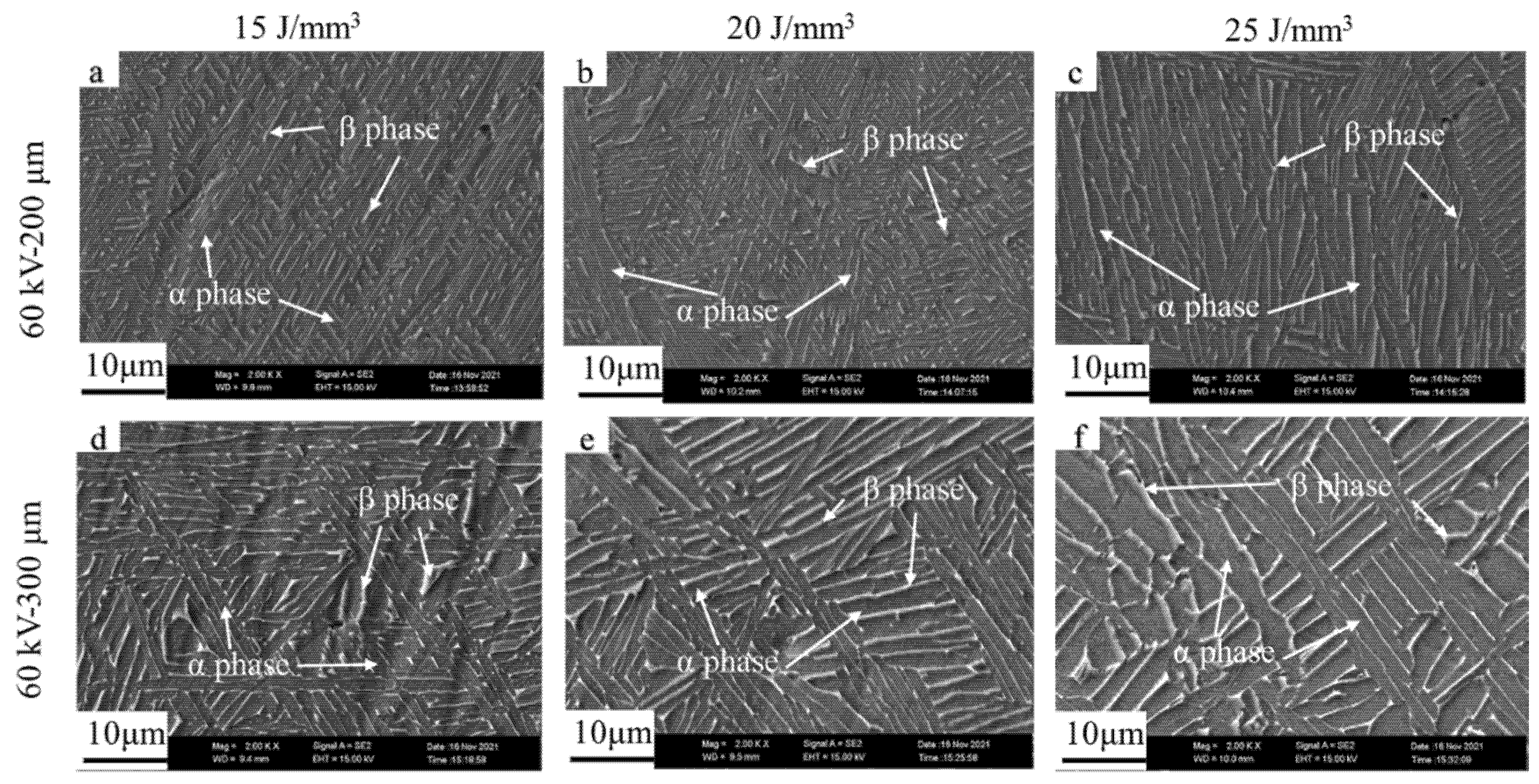
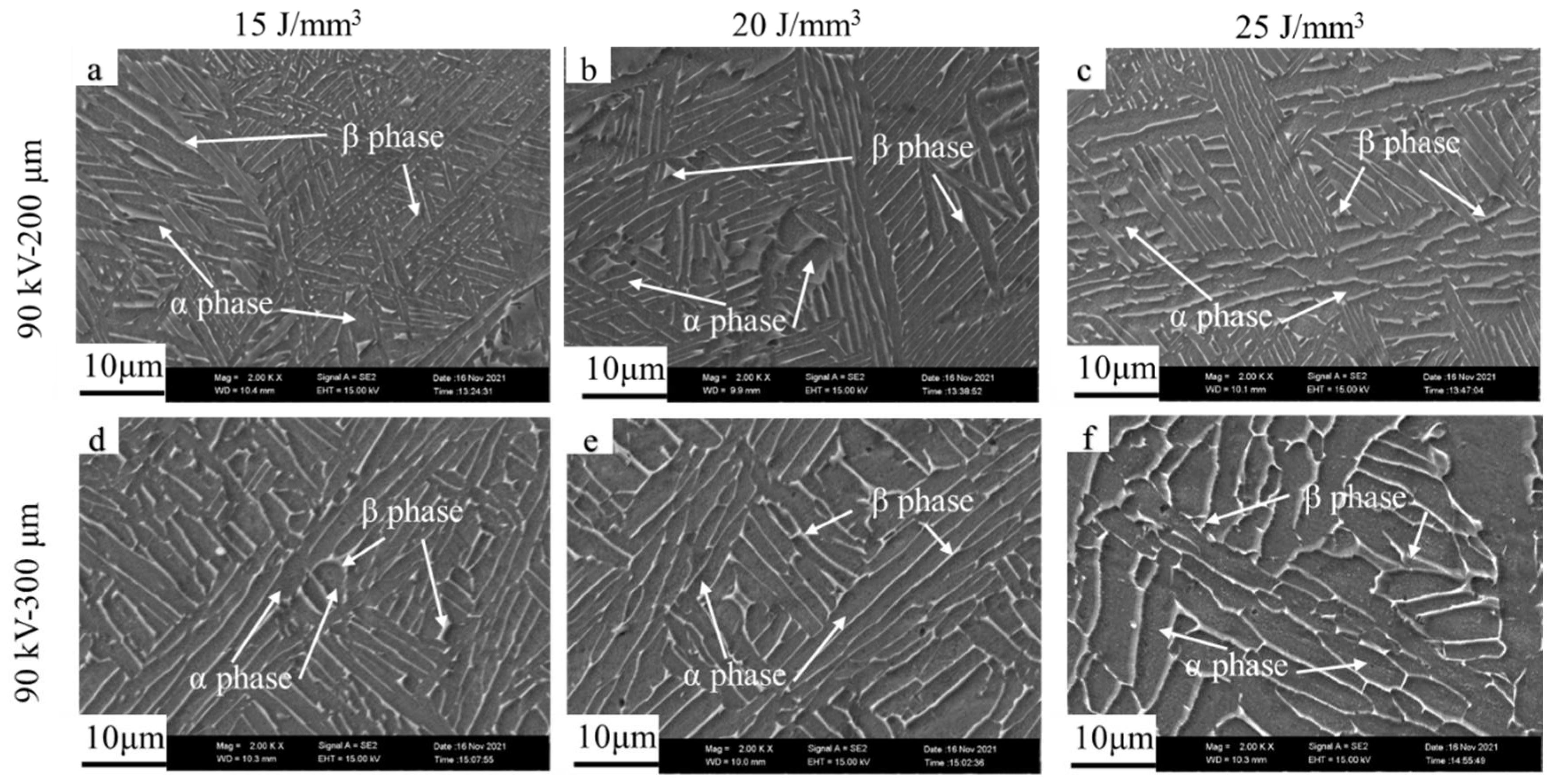
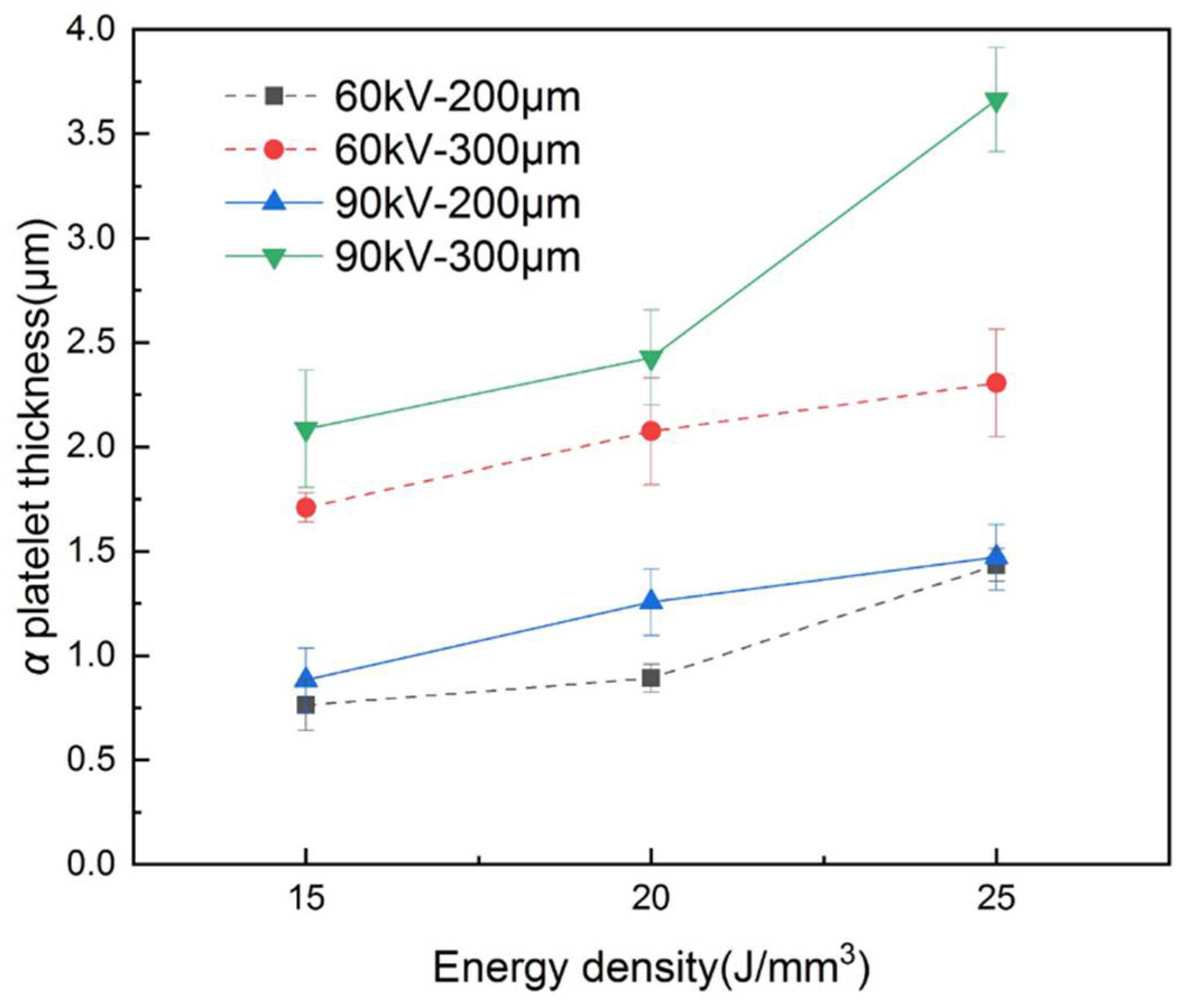
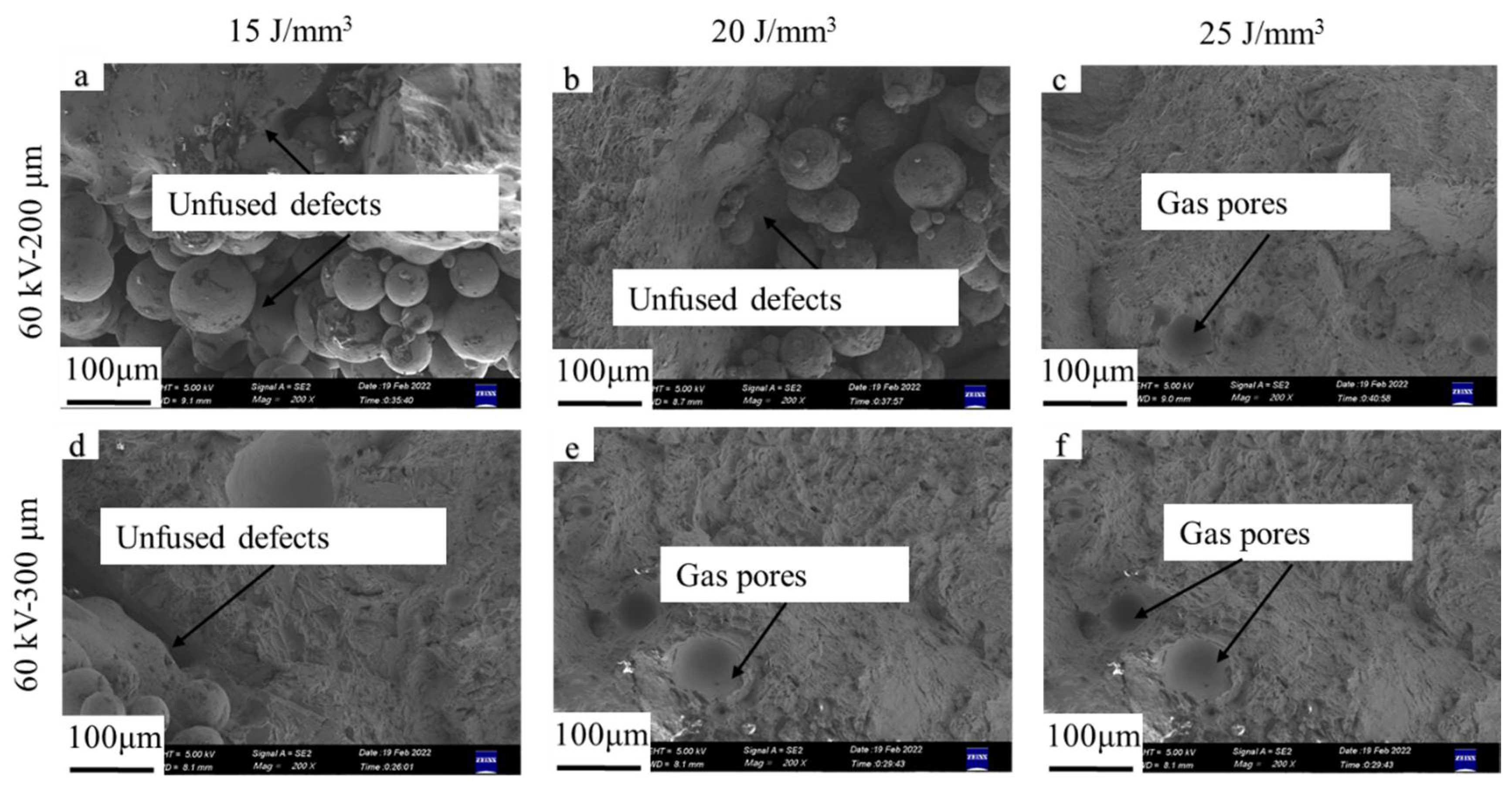
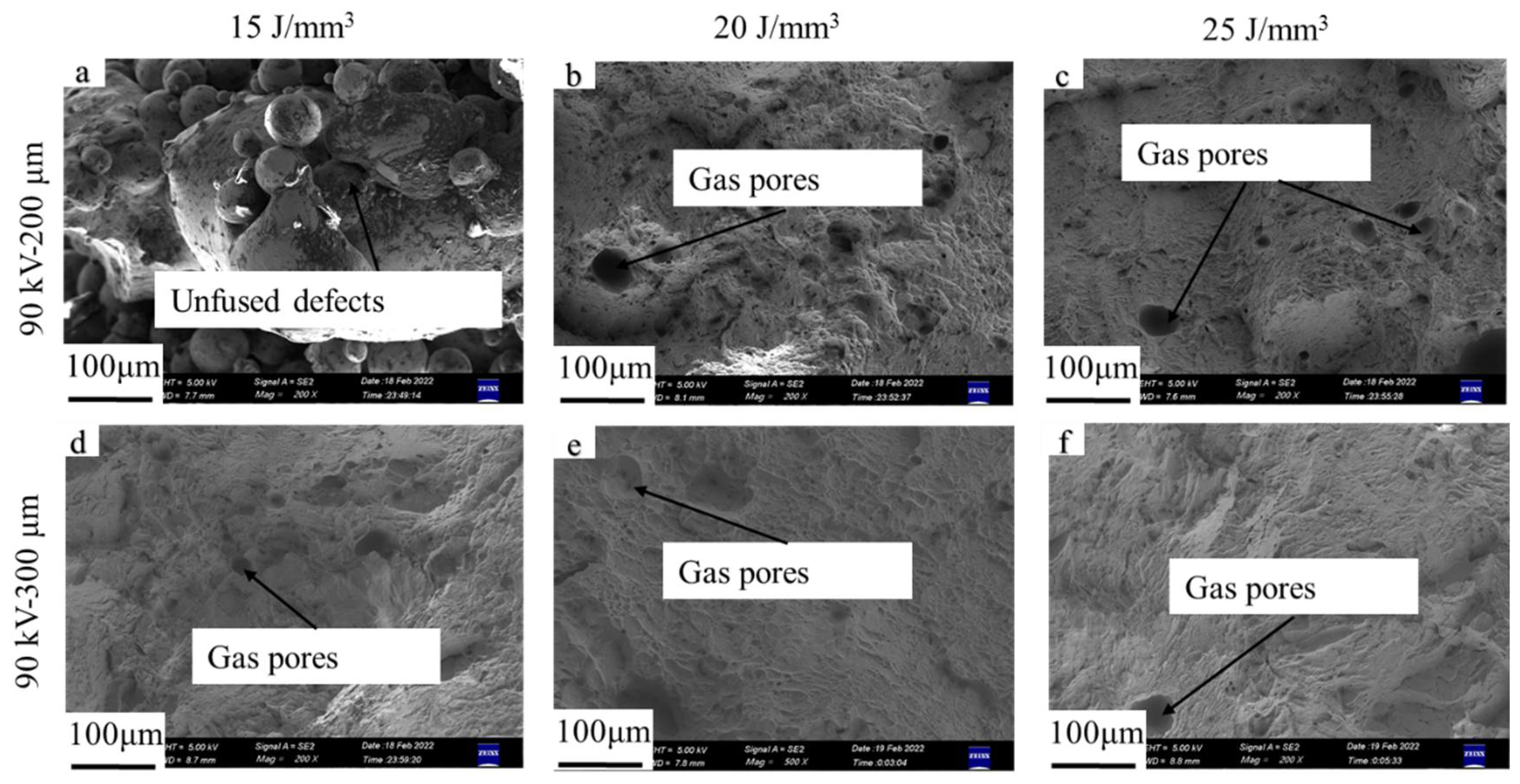
| Element | Ti | Al | V | Fe | O | N |
|---|---|---|---|---|---|---|
| wt.% | Balance | 6.16 | 4.30 | 0.16 | 0.09 | <0.01 |
| Sample Number | Layer Thickness (μm) | Accelerating Voltage (kV) | Beam Current (mA) | Energy Density (J/mm3) |
|---|---|---|---|---|
| 1 | 200 | 60 | 5 | 15 |
| 2 | 200 | 60 | 6.67 | 20 |
| 3 | 200 | 60 | 8.33 | 25 |
| 4 | 300 | 60 | 7.5 | 15 |
| 5 | 300 | 60 | 10 | 20 |
| 6 | 300 | 60 | 12.5 | 25 |
| 7 | 200 | 90 | 3.33 | 15 |
| 8 | 200 | 90 | 4.44 | 20 |
| 9 | 200 | 90 | 5.56 | 25 |
| 10 | 300 | 90 | 5 | 15 |
| 11 | 300 | 90 | 6.67 | 20 |
| 12 | 300 | 90 | 8.33 | 25 |
| Sample Number | 1 | 2 | 3 | 4 | 5 | 6 |
|---|---|---|---|---|---|---|
| Relative density (%) | 93.94 ± 0.15 | 95.90 ± 0.13 | 99.60 ± 0.10 | 97.17 ± 0.17 | 99.86 ± 0.04 | 99.66 ± 0.07 |
| Sample Number | 7 | 8 | 9 | 10 | 11 | 12 |
| Relative density (%) | 95.91 ± 0.10 | 99.77 ± 0.12 | 99.71 ± 0.05 | 99.73 ± 0.13 | 99.87 ± 0.08 | 99.88 ± 0.07 |
| Sample Number | Layer Thickness (μm) | Accelerating Voltage (kV) | Energy Density (J/mm3) | Yield Strength (MPa) | Ultimate Tensile Strength (MPa) | Elongation (%) |
|---|---|---|---|---|---|---|
| 1 | 200 | 60 | 15 | 277 ± 21 | 283 ± 17 | 1.0 ± 0.1 |
| 2 | 200 | 60 | 20 | 582 ± 11 | 590 ± 13 | 0.5 ± 0.1 |
| 3 | 200 | 60 | 25 | 969 ± 7 | 1077 ± 3 | 9.2 ± 0.4 |
| 4 | 300 | 60 | 15 | 519 ± 114 | 590 ± 115 | 1.6 ± 0.2 |
| 5 | 300 | 60 | 20 | 962 ± 2 | 1072 ± 5 | 9.3 ± 1.9 |
| 6 | 300 | 60 | 25 | 961 ± 26 | 1082 ± 29 | 10.3 ± 0.6 |
| 7 | 200 | 90 | 15 | 285 ± 19 | 310 ± 37 | 2.9 ± 0.2 |
| 8 | 200 | 90 | 20 | 839 ± 6 | 950 ± 7 | 13.4 ± 1.1 |
| 9 | 200 | 90 | 25 | 840 ± 20 | 962 ± 8 | 10.4 ± 0.3 |
| 10 | 300 | 90 | 15 | 927 ± 15 | 1034 ± 28 | 9.9 ± 1.9 |
| 11 | 300 | 90 | 20 | 877 ± 13 | 994 ± 5 | 11.3 ± 0.2 |
| 12 | 300 | 90 | 25 | 943 ± 11 | 1054 ± 3 | 10.1 ± 0.6 |
Publisher’s Note: MDPI stays neutral with regard to jurisdictional claims in published maps and institutional affiliations. |
© 2022 by the authors. Licensee MDPI, Basel, Switzerland. This article is an open access article distributed under the terms and conditions of the Creative Commons Attribution (CC BY) license (https://creativecommons.org/licenses/by/4.0/).
Share and Cite
Li, H.; Liang, X.; Li, Y.; Lin, F. Performance of High-Layer-Thickness Ti6Al4V Fabricated by Electron Beam Powder Bed Fusion under Different Accelerating Voltage Values. Materials 2022, 15, 1878. https://doi.org/10.3390/ma15051878
Li H, Liang X, Li Y, Lin F. Performance of High-Layer-Thickness Ti6Al4V Fabricated by Electron Beam Powder Bed Fusion under Different Accelerating Voltage Values. Materials. 2022; 15(5):1878. https://doi.org/10.3390/ma15051878
Chicago/Turabian StyleLi, Hongxin, Xiaoyu Liang, Yang Li, and Feng Lin. 2022. "Performance of High-Layer-Thickness Ti6Al4V Fabricated by Electron Beam Powder Bed Fusion under Different Accelerating Voltage Values" Materials 15, no. 5: 1878. https://doi.org/10.3390/ma15051878






